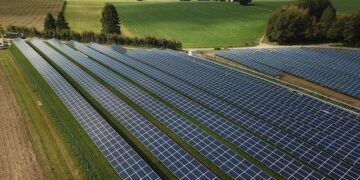Analysis of the Water Ecological Restoration Sector: Infrastructure Insights
As global awareness grows regarding the essential role that healthy ecosystems play in sustaining life, the water ecological restoration sector is emerging as a crucial area for environmental recovery and sustainability. Recent insights reveal the complex dynamics of this expanding market, particularly focusing on the infrastructure necessary for effective restoration initiatives. With climate change, pollution, and urban development posing significant threats to our water resources, stakeholders—including government bodies and private enterprises—are increasingly acknowledging the urgent need for innovative solutions. This article explores current trends, challenges, and opportunities within the water ecological restoration domain while emphasizing key players and examining how strategic investments in infrastructure can facilitate the revival of critical aquatic ecosystems.
Trends in Water Ecological Restoration and Infrastructure Innovations
The landscape of water ecological restoration is undergoing notable transformations as both public institutions and private organizations recognize the importance of sustainable practices. Cutting-edge technologies are being implemented to tackle issues such as water contamination, habitat loss, and climate impacts. Prominent trends include embracing sustainable infrastructure solutions, like artificial wetlands and bioswales that not only enhance water quality but also beautify urban environments. Additionally, new legislative measures are emerging that enforce stricter regulations on water management practices—prompting increased investment in restoration efforts.
The development of robust infrastructure is vital to this evolving market scenario. Stakeholders are now prioritizing intelligent water management systems, which leverage IoT technology for real-time monitoring and data-driven decision-making processes aimed at optimizing resource distribution while streamlining restoration activities. Furthermore, partnerships between governmental agencies and private companies are fostering innovative models through public-private collaborations, enhancing efficiency in various projects focused on restoring aquatic environments. As demand escalates alongside technological advancements, this sector is set for substantial growth—a reflection of a holistic approach to ecological rehabilitation.
Investment Opportunities Within Water Restoration Initiatives
The escalating global demand for clean drinking water has made investment opportunities within water restoration projects increasingly appealing. Areas grappling with severe drought conditions are turning towards ecological rehabilitation as a practical solution—resulting in heightened funding interest across these regions. Several key factors driving these investments include:
- Government Support: Numerous governments provide tax incentives or subsidies aimed at encouraging private sector participation in restorative efforts.
- Technological Progress: Advances in purification methods and waste management technologies have rendered many restoration initiatives more efficient economically.
- Tighter Environmental Regulations: Stricter compliance requirements compel businesses to invest more heavily into sustainable practices—thereby increasing demand for restorative actions.
Apart from environmental advantages, investors also recognize potential economic benefits tied to revitalizing aquatic ecosystems; improved waterways can elevate property values while boosting local economies through tourism-related activities. A recent study indicates that certain projects may yield impressive returns on investment (ROI), especially within areas vulnerable to droughts or pollution challenges. The following table outlines estimated ROI across various types of water restoration endeavors:
| Type of Project | Plausible ROI (%) | Total Duration (Years) |
|---|---|---|
| Biodiversity Wetland Rehabilitation | 15-20% | 5-7 years |
| Erosion Control along Riverbanks | 12-18%< td >3 – 5 years < tr >< td >Forest Regeneration < td >10 - 15% < td >6 – 10 years |
Strategic Guidelines for Stakeholders Engaged in Water Ecosystem Restoration Efforts
If stakeholders aim to maximize their investments’ effectiveness concerning ecosystem rehabilitation efforts related specifically towards watersheds—they should prioritize cross-sector collaboration strategies involving local communities alongside governmental entities plus environmental advocacy groups facilitating knowledge exchange coupled with resource sharing capabilities.
Establishing strong partnerships will lead toward integrated methodologies regarding technology adoption along with funding mechanisms ultimately enhancing project sustainability outcomes.
Moreover adopting novel financing frameworks such as pay-for-success models or environmental impact bonds ensures consistent financial backing throughout all phases involved during implementation stages associated with these restorations.< / p >
Additionally employing data-centric approaches proves essential when executing successful initiatives; implementing comprehensive monitoring & evaluation systems allows participants involved identify obstacles & prospects promptly enabling timely adjustments made accordingly based upon findings derived from analyses conducted regularly over time periods specified beforehand .< br />< br />Raising public awareness campaigns designed engage community members fosters support surrounding ongoing conservation endeavors too! Below we present an overview highlighting key sectors paired together potential collaborative actions promoting effective watershed rehabilitations :
| < strong>Sectors Involved< / strong > | < strong>Pursued Collaborative Actions< / strong > < / tr > < /thead > |
|---|---|
| < strong >Governmental Entities< / strong > | Policy formulation , grant allocations , regulatory assistance provided by authorities .< / li>. |
| < strong >Private Enterprises< / strong >>Investments directed towards advanced technologies plus shared resources among partners .<<
/ t d >> / r | |
| >Non-Profit Organizations << / t d >> | >Advocacy work combined with community outreach programs designed raise awareness levels about importance protecting natural habitats .<< / t d >> |
| >Academic Institutions << / t d >> | >Collaborative research ventures leading dissemination knowledge gained throughout studies conducted jointly over time frames established previously agreed upon by parties involved .<<
/ t d >>
<> Final Thoughts on Water Ecological Restoration Market Growth PotentialThe future outlook surrounding The Water Ecological Restoration Sector appears promising given rising emphasis placed upon sustainable methodologies adopted globally today! Increased focus directed toward developing infrastructures geared specifically around restoring vital aquatic habitats signifies recognition amongst diverse stakeholder groups ranging from governmental agencies down through corporate entities alike recognizing significance clean freshwater supplies contribute overall health well-being society at large ! Insights gleaned herein underscore pressing necessity embrace cutting-edge innovations coupled robust strategic planning address myriad challenges confronting contemporary day-to-day operations undertaken restore balance nature’s delicate equilibrium ! Moving forward collaboration remains paramount driving success behind these transformative initiatives ensuring resilient sustainable future awaits us all ahead! For those seeking deeper understanding further exploration available via detailed examination encompassing market dynamics pivotal players infrastructural advancements found full report accessible openPR.com Stay tuned continue tracking developments unfolding rapidly within this ever-evolving landscape! |































